SYNOPSIS
!
SPOILER ALERT !
Agent of
S.H.I.E.L.D. Jasper Sitwell is minding
the store while Iron Man is out of the
coutry, first fighting the Mandarin in
China and then Dreadknight in the grounds
of Castle Frankenstein in Switzerland.
Unfortunately, things are not as calm as
Sitwell was expecting them to be, as he
discovers that Tony Stark's personal
secretary, Krissy Longfellow, along with
employee Harry Key, has been involved in
industrial espionage and selling out
Stark Industries behind his back to one
Mordecai Midas (first introduced in Iron
Man #17, September 1969), an
individual obsessed by Ancient Greece.
Following a
car chase Longfellow and Key manage to
shake off Sitwell, but when Key has to
admit his failure to Midas in regard of
procuring one of Iron Man's spare armour
suits, he is pushed to his death off of
Midas' Flying Fortress (which resembles a
flying akropolis). His co-conspirator
Krissy Longfellow then reveals herself to
Midas as being Madam Masque.
Meanwhile,
in France, Tony Stark is on his way back
home from Switzerland and, in his Iron
Man identity, boards a plane from Paris
to New York by commerical jetplane. Upon
his arrival, however, he discovers that
Midas has bought out much of the Stark
Industries board and has de facto taken
over the company. Following a brief
skirmish with Jack of Hearts at the
company's facility, Iron Man also learns
who Krissy Longfellow really is - and
gets told by Midas that he is fired after
Stark has now lost everything.
Thunderstruck, Iron Man grabs Madam
Masque and takes off, while elsewhere
Tony Stark's telepathic ex-girlfriend
Marianne Rodgers is released from a
sanitarium.
|
|
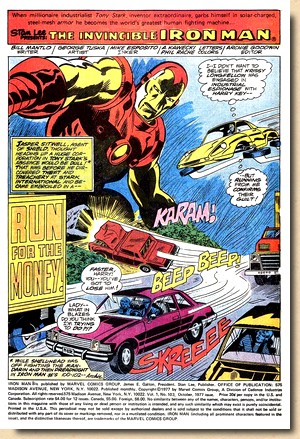 |
|
|
| |
REVIEW & ANALYSIS
Iron Man
#103 kicks off a five-issue story arc which would be
concluded in Iron Man #107 (February 1978 cover
date). Most people don't rate it too highly, while some
even consider it to be a true lemon. The plot is somewhat
scattered and some of the character concepts are
outrageously overblown even for a 1970s comic book, but
there are a few nice touches here and there.
Written by
Bill Mantlo, the first four instalments were the final
Iron Man issues pencilled by George Tuska and inked by
Mike Esposito before Keith Pollard and Fred Kida took
over as of Iron Man #107, after which Pollard
became the book's regular penciller following a brief
stint by Carmine Infantino for issues #108 and #109.
Bill Mantlo
(born in 1951)was a
prolific writer for Marvel from the mid-1970s to the
early 1980s, working on many major titles (such as Iron
Man and Hulk) while really making a name
for himself through his handling of licensed properties
comic book adaptations, most famously ROM and Micronauts.
He co-created a number of characters (e.g. Rocket
Raccoon) and was the first writer to have Luke Cage
exclaim his now famous tagline "Sweet
Christmas". It was a career which had developed out
of not too promising beginnings:
"I was unemployed
(...) and then an old college friend, Annette
Kawecki, called. Seems she had gotten a job as a
letterer at Marvel Comics, and wondered if I'd be
interested in doing past-ups and mechanicals for them. (...) I was interviewed by
the late John Verpoorten, hired, and became his
assistant, doing the most mindless production work
there is." (Bill Mantlo in BEM, 1979)
Mantlo
was more than modest regarding his self-appreciation
("I would write any character quickly and, while
my plotting was weak, everyone liked my dialogue",
BEM 1979), but for many he was indeed simply Marvel's
fill-in king, "able
to write quickly and help multiple series avoid reprints
or delayed releases when regular writers missed
deadlines" (McMillan, 2017). When it came to
Iron Man, however, his plotting and writing was spot on
most of the time, and he penned numerous great stories
between 1976 and 1978 while also adding some nice touches
along the way.
Mantlo's ability to add some
comic relief on the fly also shows in Iron Man
#103, when an Iron Man desperate to board a jet home is
struggling with French airport security -after all, it is
true that "anyone could wear such a
costume".
|
| |
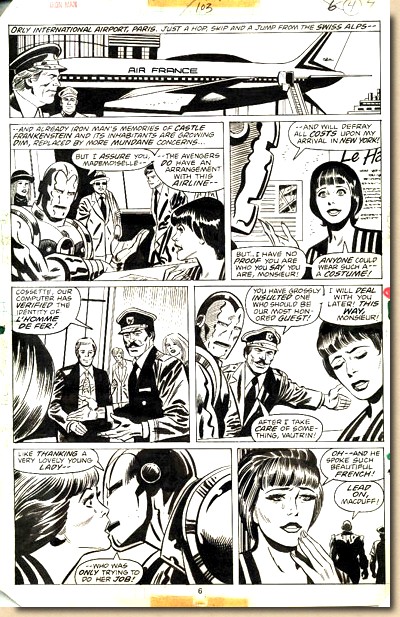 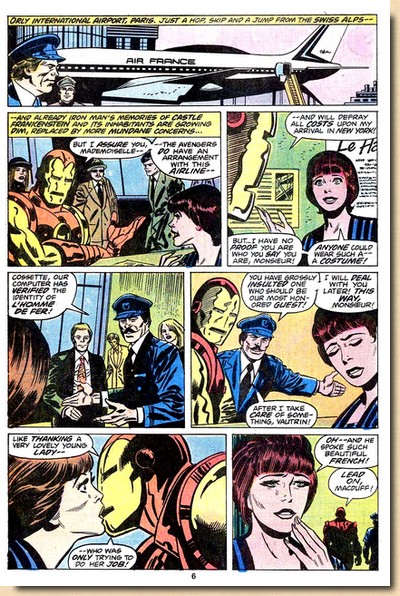
Original
artwork by George Tuska (pencils) and Mike Esposito
(inks) for page 6 of Iron Man #103 (scanned from the
original)
the same page as it appeared in print (colouring by Phil
Rachelson)
|
| |
| At the same time, the
reference to Iron Man's reason of being at Paris Orly (en
route from Castle Frankenstein in the Swiss Alps) is also
a pointer to a lesser piece of work by Mantlo from 1975:
his scripting for Frankenstein
Monster #18, the final issue from that series
before it was cancelled. A muddled closing to a title on
the slide, Mantlo felt he wanted to give readers who
remembered the dangling plotlines some closure - and thus
sent Iron Man to Switzerland where, indeed, some open
questions from Frankenstein Monster #18 were
answered in Iron Man #101 and #102. Mantlo left the comic
book industry in the late 1980s after having successfully
attended law school. In 1992 he was struck by a car and suffered
severe head trauma; thanks to a new deal struck with
Marvel Comics over his creator rights for Rocket Raccoon
and the Guardians of the Galaxy movies Mantlo
has been able to move from a nursing home to his own flat
in 2017.
|
| |
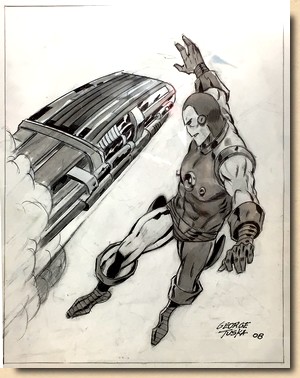
Original pencil
and ink artwork by George Tuska (2008
commission, scanned from the original)
|
|
| George Tuska
(1916 - 2009) was already a
seasoned comic book industry
veteran who had started out back
in 1939 with Fox Comics. His
first work at Marvel Comics was
for Tales of Suspense #58
(November 1964) where he
pencilled the last "Tales of
the Watcher" feature to
appear in that title (Captain
America moved in to replace
them). Thus already
close to Iron Man (who at the
time starred in Tales of
Suspense before
getting his own title in May
1968), Tuska finally found
himself pencilling Ol' Shellhead
for the first time in September
1968 (Iron Man #5).
|
|
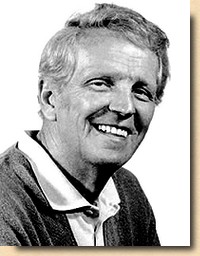
George
Tuska in the 1960s
|
| |
|
|
It would prove to be
a definitive match as Tuska went on to
pencil Iron Man for what would turn out
to be a period of almost 10 years (with a
few brief interruptions here and there).
During that time, Tuska developed and
shaped the visuals of the character into
what became nothing less than the iconic
look of Iron Man for the entire Bronze
Age.
|
|
|
| |
| He gave the
armour weight (something which had previously been
lacking most of the time) yet added a dynamic to the look
which made it just so more believable that this guy could
actually fly. His knowledge of both anatomy and mechanics
resulted in physical poses and technical gadgets which
just sat perfectly right, and as he also had an eye for
composition he managed to convey movement in a way which
could make some panels seem to almost pop right out of
the page. |
| |
In short, Tuska and
Iron Man were a perfect combination
(although he also brought his pencilling
talent to a number of other Marvel titles
throughout the 1970s).
"[George
Tuska's] layouts were certainly more
imaginative than the standard at the
time, and the way in which characters
(...) held a lot of their strength in
their shoulders and punched from
their legs up through their torsos
betrayed his knowledge of strength
and fitness. His signature flourish
may have been characters in arrested
motion, coiled in preparation for
violence (...), legs splayed in the
form of a near-base ready for what
might come next. (Spurgeon,
2009)
|
|
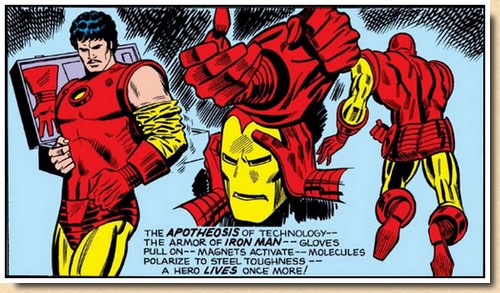
Iron Man #57
(April 1973)
|
|
|
| |
| Which is why, even though
Iron Man #103 has a few stutterings on the level of
plot and storytelling, the issue still comes across as
visually dynamic. It's also what made Tuska so valuable
for Marvel: he could keep even a mediocre tale from
sinking and still give it a spin. |
| |
| |
FACTS & TRIVIA
Iron Man #103 went on sale in the
US on 26 July 1977; two variant cover versions exist: a
limited distribution (i.e. price increase reception test)
35˘ price cover and a Whitman edition.
The
colourists name is given as Phil Rache in the credits on
the splashpage, whereas his correct full name is actually
Phil Rachelson.
|
| |
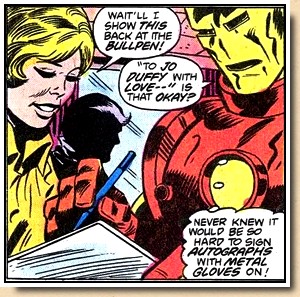 |
|
Most
of the single page letters page (aptly
called "printed circuits") of
this issue is taken up by Bill Mantlo^s
background notes on Jack of Hearts, who
would become a recurring character in
future issues.
Other than the
airport security scene, Mantlo stuck
another humorous piece into this issue by
actually featuring Mary Jo Duffy as an
autograph chaser on that Air France
flight. Essentially an in-joke, her
remark "wait'll I show this back
at the bullpen" is a clue -
Mary Jo Duffy actually started work as an
editor for Marvel Comics in 1977.
Iron Man
#103 has so far not been reprinted,
although the Masterworks series will no
doubt eventually catch up with it. It
has, however, been published for the
French market by Editions Lug (Strange
#105, September 1978), in Swedish by
Atlantic Förlads AB (in Atlantic
Special #1, 1981), in Norwegian by
Atlantic Forlag (in Atlantic Spesial 31,
1981), and for the Spanish market by
Panini (in Biblioteca Marvel: Iron
Man #21, 2007).
|
|
|
| |
| |
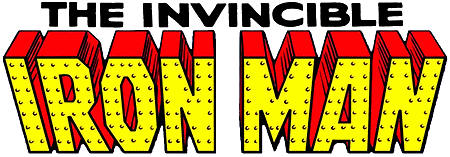
|
| |
| |
| BIBLIOGRAPHY BEM
(1979) "Bill Mantlo
and the Micronauts", interview originally
published in BEM Fanzine #24 (July
1979)
McMillan
Graeme (2017) "Beyond Rocket Raccoon: Bill Mantlo's
Often Overlooked Comic Book Career", in Hollywood Reporter,
4 May 2017
Spurgeon
Tom (2009) "George Tuska, 1916-2009", in Comics Reporter
(16 October 2009)
|
| |
| |
The illustrations
presented here are copyright material.
Their reproduction for the review and
research purposes of this website is
considered fair use
as set out by the Copyright Act of 1976,
17 U.S.C. par. 107.

(c) 2017-2018
|
|
|
|